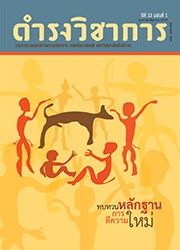A NEW INTERPRETATION OF THE BOUNDARY OF DVDRAVATI SHORELINE ON THE LOWER CENTRAL PLAIN
Keywords:
Lower Central Plain, Holocene Maximum Transgression, Phytogeography, Palaeo-shoreline of DvaravatiAbstract
This research analyzed phytogeographical evolution during the Holocene in the Lower Central Plain by using multidisciplinary method for geomorphology, palynology and radiocarbon dates in order to create palaeo-shoreline in Dvaravati period. The results indicated that palaeo-shoreline throughout the Holocene is characterized by a strip of mangrove ecology. The marine phenomenon of the Holocene Maximum Transgression has occurred around 8,400 cal BP, resulting in the reach of sea-water into vicinity of Suphan Buri and Ang Thong provinces. Then, the marine regression has occurred since 7,000 cal BP, resulting that the palaeo-shoreline has moved continuously southward to the present level. The palaeo-shoreline of Dvaravati, thus, was located in vicinity of southern part of Bangkok to Phra Pra Daeng District, Samut Prakan Province. Boundary of the palaeo-gulf of Dvaravati could not extend northward beyond Bangkok and it is impossible that sea water has reached to the locations of those key cities of Dvaravati, such as U-Thong and Ancient Nakhon Pathom.
References
คณะกรรมการฝ่ายประมวลเอกสารและจดหมายเหตุ. (2542). วัฒนธรรม พัฒนาการทางประวัติศาสตร์ เอกลักษณ์และภูมิปัญญา จังหวัดฉะเชิงเทรา. กรุงเทพฯ: กระทรวงมหาดไทย กระทรวงศึกษาธิการ กรมศิลปากร.
ผ่องศรี วนาสิน และ ทิวา ศุภจรรยา. (2524). รายงานผลการวิจัยทุนวิจัยรัชดาภิเษกสมโภชเรื่องเมืองโบราณบริเวณชายฝั่งทะเลเดิมของที่ราบภาคกลางประเทศไทย: การศึกษาตําแหน่งที่ตั้งและภูมิศาสตร์สัมพันธ์. งานวิจัยจุฬาลงกรณ์มหาวิทยาลัย ลําดับที่ 1. กรุงเทพฯ : โครงการเผยแพร่ผลงานวิจัย ฝ่ายวิจัย จุฬาลงกรณ์มหาวิทยาลัย.
ผาสุข อินทราวุธ. (2542). ทวารวดี การศึกษาเชิงวิเคราะห์จากหลักฐานทางโบราณคดี. กรุงเทพฯ: โรงพิมพ์อักษรสมัย.
ศึกษาธิการอําาเภอบางน้ำเปรี้ยว, สํานักงาน. (2541). วัฒนธรรมพัฒนาการทางประวัติศาสตร์ เอกลักษณ์ และภูมิปัญญา อําาเภอบางน้ำเปรี้ยว. ฉะเชิงเทรา: สําานักงานศึกษาธิการอําเภอบางน้ำเปรี้ยว.
สด แดงเอียด. (2521). “การปฏิบัติงานขุดสําารวจแหล่งโบราณคดีโคกพลับ.” ศิลปากร 22, 4 (พฤศจิกายน): 22-31.
สมภพ วงศ์สมศักดิ์, เสริมศักดิ์ ตียะพันธ์, นุกูล หนูศรี และเจริญ อินทะเสน. (2530). ธรณีวิทยาระวางอําเภอผักไห่ (5037 I) และระวางอําเภอลาดหลุมแก้ว (5037 II). รายงานการสํารวจธรณีวิทยา ฉบับที่ 86. กรุงเทพฯ: กองธรณีวิทยา กรมทรัพยากรธรณี.
สิริประภา เทพวิมลเพชรกุล. (2555). “การเปลี่ยนแปลงสภาพภูมิสัณฐานและพืชพรรณในพื้นที่ราบลุ่มภาคกลางตอนล่างที่เกิดจากการถอยร่นของนํ้าทะเลในช่วงสมัยโฮโลซีนตอนปลาย.” วิทยานิพนธ์ปริญญาดุษฎีบัณฑิต สาขาโบราณคดีสมัยประวัติศาสตร์ ภาควิชาโบราณคดี บัณฑิตวิทยาลัย มหาวิทยาลัยศิลปากร.
สุริยา สุดสวาท และ เดชา สุดสวาท. (2553). ทะเบียนโบราณสถานจังหวัดสมุทรสาคร. ราชบุรี: กลุ่มโบราณคดี สําานักศิลปากรที่ 1 ราชบุรี.
Alekseev M.N., and Takaya Y. (1967). “An Outline of the Upper Cenozoic Deposits in the Chao Phraya Basin, Central Thailand.” Southeast Asian Studies 5, 2 : 334-352.
Bird M.I., Taylor D., and Hunt C. (2005). “Palaeoenvironments of Insular Southeast Asia during the Last Glacial Period: A Savanna Corridor in Sundaland?” Quaternary Science Reviews 24: 2228-2242.
Chonglakmani C., Ingavat R., Piccoli G., and Robba E. (1983). “The Last Marine Submersion of the Bangkok Area in Thailand.” Memorie di Scienze Geologiche, vol. XXXVI: 343-352.
Dheeradilok P. (1995). “Quaternary Coastal Morphology and Deposition in Thailand.” Quaternary International 26: 49-54.
Higham C., and Thosarat R. (1998). Prehistoric Thailand: from Early Settlement to Sukhothai. Bangkok: River Books.
Hutangkura T. (2012). “Pollen Analysis of the Holocene Sedimentary Sequences from the Lower Central Plain of Thailand and Its Implications for Understanding Palaeo-environmental and Phytogeographical Changes.” Nice: Thesis (Ph.D.), Ecole Doctorale 86, Lettres, Arts et Sciences Humaines, Université de Nice Sophie Antipolis.
Jarupongsakul S. (1987). “Stratigraphy of Bangkok Clay and Holocene Transgression of The Chao Phraya Delta, Central Thailand.” Kyoto : Thesis (M.Sc.), Graduate School of Agriculture, Kyoto Prefectural University.
Kealhofer L., and Piperno D.R. (1994). “Early Agriculture in Southeast Asia: Phytolith Evidence from the Bang Pakong Valley, Thailand.” Antiquity 68, 260: 564-572.
Maloney B.K. (1991). “Palaeoenvironments of Khok Phanom Di : The Pollen, Pterdophyte Spore and Microscopic Charcoal Record.” In : The Excavation of Khok Phanom Di, a Prehistoric Site in Central Thailand. Vol. II: The Biological Remains (Part I), 7-44 Higham C.F.W., Bannanurag R. (eds.), The Society of Antiquaries of London.
Maloney B.K., and Rovner I. (1991). X. The Phytoliths. In : The Excavation of Khok Phanom Di, a Prehistoric Site in Central Thailand. Vol. II: The Biological Remains (Part I), 135-138. Higham C.F.W., Bannanurag R. (eds.). The Society of Antiquaries of London.
Mix A.C., Bard E., and Schneider R. (2001). “Environmental Processes of the Ice Age: Land, Oceans, Glaciers (EPILOG). Quaternary Science Reviews 20: 627-657.
Ramnarong V., Buapeng S. (1992). “Groundwater Resources of Bangkok and Its Vicinity impact and management.” In Proceedings on Geological Resources of Thailand: Potential for Future Development, 172-184. 17-24 November 1992, Bangkok.
Negri M.P. (2009). “Fossil Mollusc-Faunas: Their Bearing on the Holocene Evolution of the Lower Central Plain of Bangkok (Thailand).” Journal of Asian Earth Sciences 35: 524-544.
Punwong P. (2007). “Pollen Deposit in Bangkok Clay from Ong Kharak District, Nakhon Nayok Province, and Their Implication on Paleophytogeography.” Bangkok: Thesis (M.Sc.), Graduate School of Chulalongkorn University.
Sinsakul S. (2000). “Late Quaternary Geology of the Lower Central Plain, Thailand.” Journal of Asian Earth Sciences 18: 415-426.
Somboon J.R.P. (1988). “Paleontological Study of the Recent Marine Sediments in the Lower Central Plain, Thailand.” Journal of Southeast Asian Earth Sciences 2, 3/4 : 201-210.
Somboon J.R.P., and Thiramongkol N., 1992. “Holocene Highstand Shoreline of the Chao Phraya Delta, Thailand.” Journal of Southeast Asian Earth Sciences 7, 1 : 53-60.
Songtham W., Phanwong P., and Seelanant T. (2007). Middle Holocene Peat and Mollusk Shells from Ongkharak Area, Nakhon Nayok, Central Thailand: Evidence of in situ Deposits during a Marine Transgression Period. GEOTHAI’07, International Conference on Geology of Thailand: Towards Sustainable Development and Sufficiency Economy: 177-179.
Stuiver M., Reimer P.J., and Reimer R. (2011). CALIB Radiocarbon Calibration. Available from : http://calib.qub.ac.uk/calib
Tachard G. (1689). Second Voyage du Père Tachard au Royaume de Siam et Des Jesuites envoyew par le roy au royame de Siam. Paris: Chez Daniel Hor Themels.
Takaya Y. (1969). “Topographical Analysis of the Southern Basin of the Central Plain, Thailand.” Southeast Asian Studies 7, 3 : 293-300.
Takaya Y. (1972). “Quaternary Outcrops of the Southern Part of the Central Plain of Thailand.” Southeast Asian Studies 10, 2 : 298-320.
Tanabe S., Saito Y., Sato Y., Suzuki Y., Sinsakul S., Tiyapairach S., and Chaimanee N. (2003). “Stratigraphy and Holocene Evolution of the Mud-Dominated Chao Phraya Delta, Thailand.” Quaternary Science Reviews 22: 789-807.
Thiramongkol N. (1984). “Geomorphology of the Lower Central Plain, Thailand.” In Proceedings of the 3rd Meeting of the Working Group on Geomorphology of River and Coastal Plains. 13-25. 11-17 December 1983. Bangkok: Department of Geology and Chulalongkorn.
Umitsu M., Tiyapairach S., Chaimanee N., and Kawase K. (2002). “Late Holocene Sea-level Chane and Evolution of the Central Plain, Thailand.” In The Symposium on Geology of Thailand, 201-206. 26-31 August 2002, Bangkok, Thailand.
Downloads
Issue
Section
License
บทความนี้เป็นผลงานของข้าพเจ้าแต่เพียงผู้เดียว และ/หรือเป็นผลงานของข้าพเจ้าและผู้ร่วมงาน ตามชื่อที่ระบุในบทความจริง และเป็นผลงานที่มิได้ถูกนำเสนอหรือตีพิมพ์ที่ใดมาก่อน





